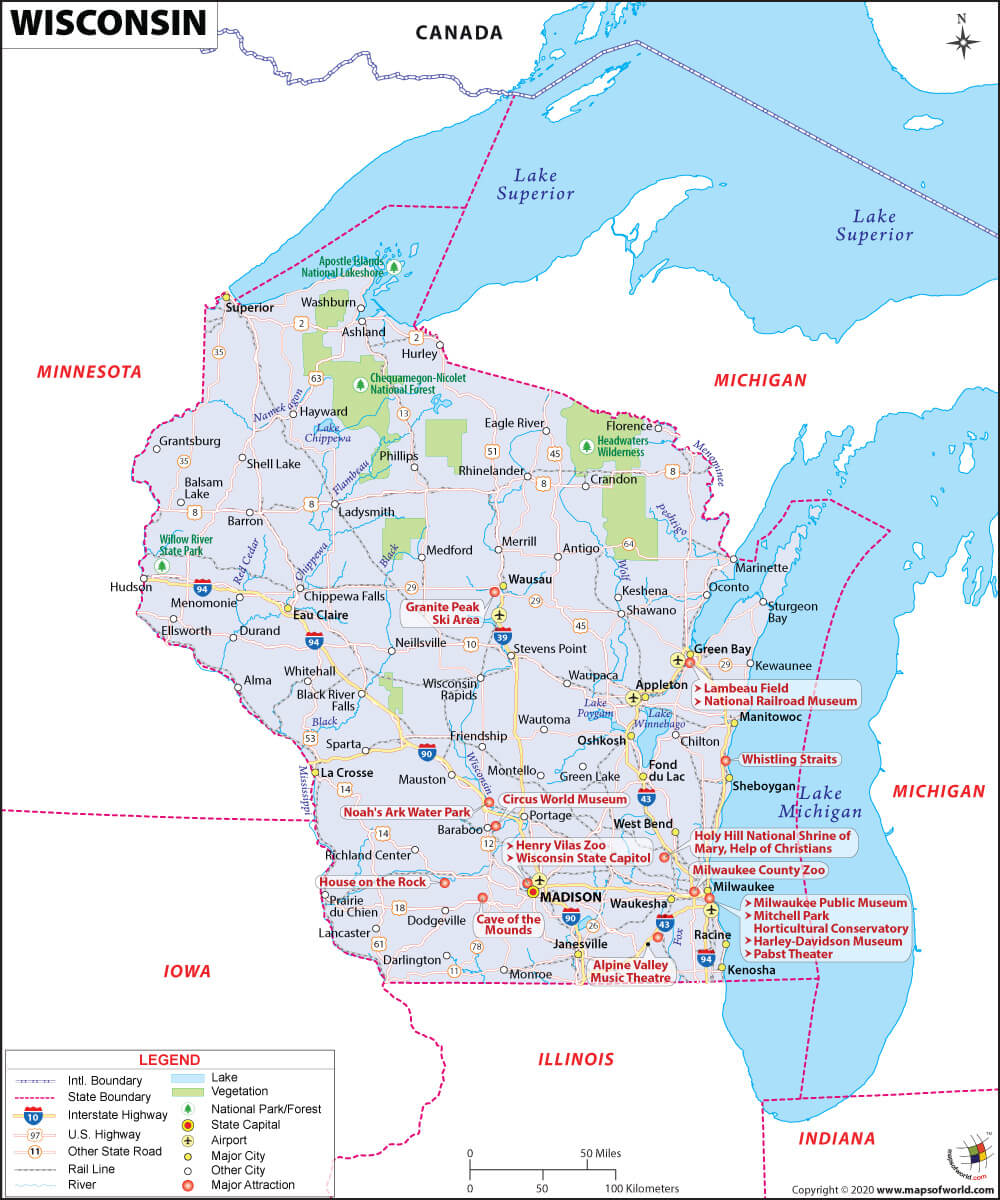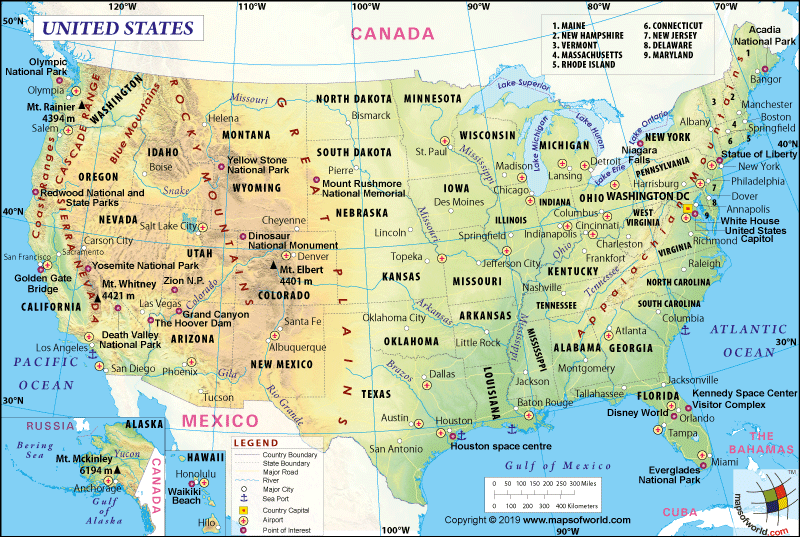What are the Key Facts of Wisconsin?

|
State |
Wisconsin |
|
State Capital |
Madison |
|
Largest City |
Milwaukee |
|
Coordinates |
44.5°N 89.5°W |
|
Nickname(s) |
“Badger State”, “America’s Dairyland” |
|
Postal Abbreviation |
WI |
|
Area |
65,498.37 sq. mi (169,640 sq. km) |
|
Highest Point |
Timms Hill, 1,951 ft (595 m) |
|
Neighboring States |
Minnesota, Michigan, Illinois, Iowa |
|
Number of Counties |
72 |
|
Population |
5,822,434 (2019) |
|
Date of Entering the Union |
May 29, 1848 |
|
State Anthem |
“On, Wisconsin!” |
|
Governor |
Tony Evers (Democrats) |
|
Lieutenant Governor |
Mandela Barnes (Democrats) |
|
U.S. senators |
Ron Johnson (Republican), Tammy Baldwin (Democrats) |
|
U.S. House Delegation |
5 Republicans, 3 Democrats |
|
GDP (millions of dollars) |
351,922 |
|
Demonym |
Wisconsinite |
|
Time Zones |
UTC−06:00 (Central), Summer (DST) UTC−05:00 (CDT) |
Where is Wisconsin?
Wisconsin lies in the North-Central, Midwest, and Great Lakes areas of the United States. Minnesota bounds it to the west, Iowa, to the southwest, Illinois, to the south. Lake Michigan also surrounds it to the east, Michigan to the northeast, and Lake Superior to the north. It was admitted to the union of the United States of America as the 30th state on May 29, 1848. Madison is the capital of Wisconsin.
What is the Geography of Wisconsin?
Wisconsin spreads across a total area of 65,498.37 sq. mi (169,640 sq. km), out of which 54,310 sq. mi (140,663 sq. km) is land, while 11,339 sq. mi (29,367 sq. km) is covered by water. Water bodies constitute 17.3% of the total area. It ranks 23rd in terms of area in the US.
The state has several remarkable rivers, and some of them are prominent like Menominee River, Wausaukee River, Pike River, and Pemebonwon River. The Wisconsin River is the longest in the state. The Wisconsin River is the longest river merely within the state. It is a tributary of the Mississippi River in the state of Wisconsin. Its length is around 430 miles (692 km) long.
The state’s mean elevation is 1,050 ft (320 m) above sea level. The highest elevation point of Wisconsin is Timms Hill, which is 1,951 ft (595 m) while its lowest elevation point is Lake Michigan, which is 579 ft (176 m).
It has several land areas, but five of them are prominent which are the Lake Superior Lowland, the Eastern Ridges and Lowlands (Great Lakes Plains), the Northern Highland, or Superior Upland, the Central Plain, and the Western Upland.
The state has many heart touching mountains, bluffs, and hills. None of them are higher than 600m. So, most of them are not in the category of mountains. But the state’s Appalachians may be called real mountains. Some of the major hills of the state are Rib Mountain (Rib Hill), Military Hill, Mosinee Hill, and Sauk Point.
The state forest of Wisconsin is managed by the Wisconsin Department of Natural Resources Division of Forestry. Here are the names of some of the major state forests: Black River State Forest, Brule River State Forest, Flambeau River State Forest, and Point Beach State Forest.
It is home to several rare species, including Badger, Beavers, Brown Bat, coyote, and Gray Squirrel. The state has about 400 bird species. Here are the names of some rare birds of Wisconsin, which are commonly known as Great Egret, Short-eared Owl, Long-eared Owl, and Upland Sandpiper.
The state tree of Wisconsin is the sugar maple, while Common blue violet is the state’s flower. Besides this, the state declared the badger as the official state animal, and American robin has been accepted as the state bird of Wisconsin.
What is the Climate of Wisconsin?
The state has a humid continental climate with typical warm-summers and cold winters.
Summer temperature is moderate and pleasant in the state, with the mercury rarely touching 90°F (32.2°C). Even in July, the temperature rarely crosses 90°F (32.2°C) only for a couple of days in the north, which stays for around 14 days in the south. The average daily temperatures in July remains 75°F (23.9°C) to 85°F (29.4°C) range statewide, while nights are pleasant where the mercury varies between 55°F (12.8°C) to 65°F (18.3°C)
The state experiences severe cold and snowy winters, and the temperature remains around -30°F (-34.4°C) in the northern part of the state. The mercury dips to -40°F (-40°C) in the coldest month in January. The average high temperatures in Wisconsin remain in the range of 23°F (-5°C) to 34°F (1.1°C) in winter, while the average low temperatures vary between 6°F (-14.4°C) to 21°F (-6.1°C) range across the state.
The northern highlands and western uplands of the state get snowfall around 160 inches (4064mm), while the rest of the state receives snowfall about 40 inches (1016mm). The state receives average annual rainfall around 35 inches (889mm), although the northwest part of Wisconsin remains wetter in comparison to the south and east. January and July are the coldest and hottest months, respectively, in the state.
What is the Economy of Wisconsin?
Agriculture plays a crucial role in the state’s economy. Wisconsin is the dairy hub of the US. Apart from milk and cheese, the state is known for the production of snap beans, potatoes, cranberries, soybeans, hay, Sweet corn, and tobacco, etc. Corn is also grown in the state, but it is mainly used to feed the livestock.
The manufacturing sector is the lifeline to Wisconsin’s economy. There were around 475,000 manufacturing employees in Wisconsin in 2018. The total revenue from manufacturing and production sector unit was $63.31 billion in 2018. The state is the leading manufacturing producer of- Food and Beverage, Tobacco Products, Machinery, Fabricated metal products, Paper manufacturing, Chemicals, Electrical equipment and appliances, Computer and electronic products, Plastics and rubber products, and many more.
Tourism is an integral part in the revenue generation in the state. It fetches a massive amount in tax receipts and creates a large number of job opportunities that help the state’s economy a lot.
The total Gross Domestic Product (GDP) of the state was the US $ 347,306.1 in 2019, while the per capita personal income in Wisconsin was US $ 53,583 in 2019.
What is the Transportation System of Wisconsin?
The federal government, along with the state of Wisconsin and local communities, work as a unit to provide a diverse network of public transportation services to the people of the state. The interstate highways constitute five current primary interstate highways and three auxiliary interstates. Prominent interstate highways of the state are 1-39, 1-41, 1-43, 1-90, 1-94 while major auxiliary interstate highways of the state are- 1-535, 1-794, 1-894.
Wisconsin is well-connected by railroad network. Railroads are a vital cog in the state for the passenger carriers as well as freight services. Some of the major passenger carriers of the state are Amtrak (AMTK), East Troy Electric Railroad (METW), Kenosha Streetcar (KAT) and many more while prestigious freight carriers in the state are- BNSF Railway (BNSF), Canadian National, Canadian Pacific, East Troy Electric Railroad, and so on
The airline network connects the state thoroughly. The state is packed with several remarkable airports; some of the major airports are Appleton International Airport, Kenosha Regional Airport, and John F. Kennedy Memorial Airport.
What is the Origin of the Name of “Wisconsin”?
The name of “Wisconsin” had emerged from Meskonsing, English spelling of the French version of the Miami Indian name for the Wisconsin River. Although the meaning of Wisconsin is “river running through a red place” (the red place points to the red sandstone bluffs of the Wisconsin Dells)
Why is Wisconsin Called “The Badger State”?
The name “Badger State” evolved, when mining became an integral part of thousands of men living in the state. The mining workers had no homes to live. Therefore, they made temporary homes by digging caves and tunnels. The miners used to live in such caves. Since then, the miners came to be known as “Badger State”. Currently, the name represents the state’s name. The state is known as “America’s Dairyland” as well.
What are the Popular Tourist Attractions in Wisconsin?
Wisconsin is an excellent place for tourists. Its diverse landscapes and vast expanses of hills are a treat to watch. Visitors can also enjoy hiking and mountain biking. The state is packed with several tourist attractions such as Oshkosh, Wisconsin State Capitol, Madison, The Harley-Davidson Museum, The Dells of the Wisconsin River, The Great Outdoors, and many more. Wisconsin is a place where tourists can enjoy every bit of their time.
Facts About Wisconsin
1.It was in 1634 that the French came to Wisconsin. At that time the state was populated by Winnebago, Dakota and Menominee tribes.
2.Wisconsin’s spelling capital is Bonduel.
3.Wisconsin gets its name from an indigenous American term that signifies the act of collecting water.
4.The first generation miners of Wisconsin used to carve out homes at the hillsides or reside at the shafts themselves. This habit resembled the Badgers. This is the reason why the state has got the pet name Badger State.
5.Gigantic glaciers had wrapped up Wisconsin’s landmass at least 12,000 years back.
6.Wisconsin is among the leading producers of cheese in USA. Its dairy agriculture has been assisted a lot by helpful climatic, topographic and soil conditions.
7.A Catholic establishment and a trading post were set up by the French in 1660. It was in 1634 that Jean Nicolet, a well known voyager from France had arrived in Green Bay.
8.USA’s dairy capital is Wisconsin. It is also referred to as America’s Dairyland on certain occasions. It also has the highest number of dairy cows in the country – 1 and a half million. It also generates 15 percent of the milk produced in USA.
9.Wisconsin’s UFO capital is Belleville.
10.The state’s Turkey capital is Boscobel.
11.Majority of the visually attractive landforms at Wisconsin were created when the ice sheets that had covered the area began to give way. All this happened during the Wisconsin Glacial Stage.
12.Various fun activities and tourism are the major sectors in the economy of the northern part of the state.
13.UK gained control of Wisconsin after the French and Indian Wars came to a conclusion in 1763. Following the end of the American War of Independence in 1863 the state was claimed by America. Still UK stayed in control of the state – something that came to an end once the War of 1812 finished.
14.There are at least 21,446 water bodies in the state and almost 66.67% of these are lakes.
15.The global jump rope capital is Bloomer.
16.The global snowmobile capital is Eagle River.
17.Wisconsin is among the top manufacturers among states in USA. The industrial sector is primarily concentrated in the southeastern area.
18.The aggregate area of this state is 65,498 square miles.
19.The Kansas-Nebraska Act was passed by the US Congress in 1854. As per this Act, people who had settled in the two states were given the choice of having slaves. However, several residents of Wisconsin opposed this move. A conference was organized so that there could be some protest against the proposed introduction of slavery in the said states. The meeting was held in Ripon and spawned the Republican Party.
20.More than 2500 musicians participate at the Summerfest. The festival is staged annually in Milwaukee, and is the biggest of its kind in USA.


